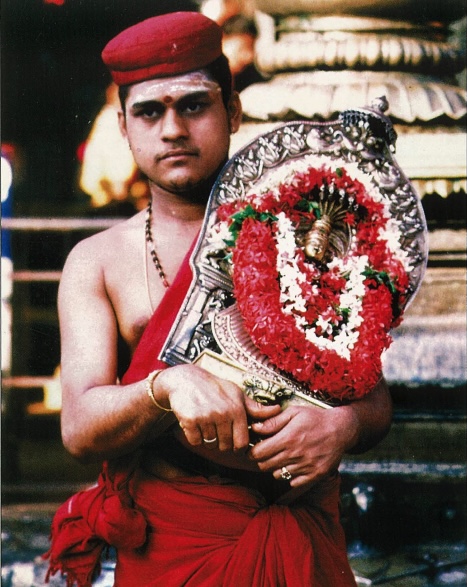By Nikki Lastreto
Once again, Sri Mukambika–the “Silent Mother”–has called me back to her powerful temple in Kollur, a typical South Indian village in Kerala State. Driving those familiar six hours from Goa, cruising down the Konkan Coast in the backseat of my Ambassador car while gazing at the glistening Arabian Sea, feels like going home. Once the car turns off the main road and onto the rough one that leads 27 kilometers into the jungle, then does the magic of Kollur truly begin to overcome me.
It’s a small village. The only reason it exists is the Goddess, and the feeling of love for Sri Mukambika is overwhelming. The one village thoroughfare is lined with trinket stalls selling everything Mukambika: from key chains to glow-in-the-dark statues. A handful of eateries are there, along with some small hotels for the pilgrims.
A few thousand pilgrims arrive daily on one of the 75 buses that roar up the otherwise bucolic narrow road. They pile out of the buses and head first for the river. There, they bathe in the sacred Suaparnika, which is said to flow through healing herbs on its course to Kollur through the dense jungles that envelop the village. After drying off and dressing in fresh clothing, they walk to the temple, drop their sandals at the gate and enter for worship. An hour later they emerge, foreheads covered with red kumkuma and vibhuti, gray ash. Then they’re back on the bus and on to the next temple.
That’s what yatra is all about. It means pilgrimage, and that’s exactly what my most recent three-weeks in India was. Kollur had special meaning to me because its symbol, the Sri Chakra, was that of both of the temple and of the California Institute of Integral Studies in America, where I work. The intricate pattern of interlocked triangles is an esoteric divine map to focus meditation and an object of worship in itself. It is seen all over the temple–in paintings, embossed in silver, on gold coins around the necks of the priests and devotees.
I went to each little trinket stall in the village and asked to view their line of Sri Chakra products. Soon I had a pile of Sri Chakras, embossed on copper and bronze, carved in crystal and silver, and stretched into the three-dimensional form of Mt. Meru, center of the universe. I gave my purchases to my regular priest.
When I returned that evening for puja, I saw the package on the Goddess’s lap, nestled in the soft folds of her brilliant silk sari, half hidden by the layers of flower garlands draped around her neck. The priest lovingly handed me back the bundle, covered in kumkuma, ashes and delicate flower petals.
My priest friend then looked at me quizzically and asked, “Why do you have so many Sri Chakras?” I explained, “Sureshji, I am now working at one university in America where the Sri Chakra is the symbol!” He was genuinely flabbergasted. When I said that it is possible to get a PhD in Hinduism at CIIS, he was ecstatic and ran about the temple showing my business card with the Sri Chakra on it to his fellow priests exclaiming my good fortune, and his good fortune to be the priest of someone connected to such a place with Sri Chakra for its symbol and PhDs in Hinduism available. This news really shook his image of America.
My days proceeded as they always do: mornings at the temple or along the river at my favorite bathing spot, lunch followed by a siesta and then perhaps an afternoon visit to a swami friend at his meditation hut, and evenings again at the ancient temple for the festive fire worship, followed by a nightly procession around the grounds. By the close of each day, I would feel full and exhausted, my head still spinning from the clanging of temple bells and my mind alive with images of Deities and Sri Chakras flickering in the firelight. Once again Sri Mukambika had worked her magic on me.
